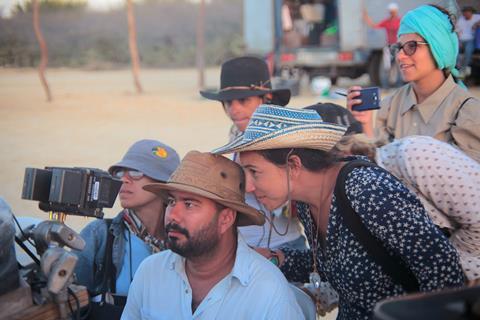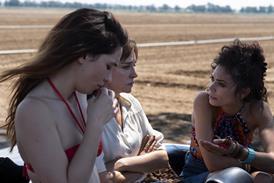To follow up their Oscar-nominated Embrace Of The Serpent, Ciro Guerra and Cristina Gallego tell another indigenous-flavoured story from Colombia’s past. Screen probes the pair on drugs drama Birds Of Passage.

Ciro Guerra and Cristina Gallego did not rest on their laurels after Embrace Of The Serpent earned Colombia’s first foreign-language Oscar nomination in 2016. The lure of mainstream entertainment was not for them. Instead, the filmmaking team threw themselves into Birds Of Passage, the 2018 Directors’ Fortnight opener at Cannes that Guerra describes as the most brutal production of their bright careers.
The drama — produced by the filmmakers’ Ciudad Lunar label and Blond Indian in association with Pimiento Films and Snowglobe, and due for distribution in the US via The Orchard next February — chronicles the origins of Colombia’s drug wars and is set in northeastern La Guajira in the 1970s, a mostly desert region where the indigenous Wayuu people were consumed by a brutal turf war.
Natalia Reyes (who will star in the latest untitled Terminator reboot) plays Zaida, the daughter of Wayuu tribal matriarch Ursula (Carmina Martinez), who unwittingly invites trouble when she accepts the hand of Raphayet (Jose Acosta) in a dazzling ceremonial opening sequence.
Raphayet struggles to meet the wedding dowry requirements and is eager to prove himself. So after he and his business partner encounter Peace Corps volunteers in need of weed, they start to trade in the drug, propelling Raphayet and the clan to dizzying heights of financial success, while ushering in a drug war across the region.
Gallego and Guerra shot in La Guajira and Colombia’s Sierra Nevada de Santa Marta mountain range from February to April 2017. Financing and support came from Proimagenes Colombia, Creative Europe, TorinoFilmLab and a patchwork of partners. “It was the toughest shoot we have ever done,” says Guerra. “The first two weeks we had a huge sandstorm over the set. Then we had to move the production to the beach. “There was a huge rainstorm that hadn’t come in six years and it destroyed the set, so we had to rebuild it. After the rain we had to rewrite the script to suit a new location.”
Birds Of Passage was never destined to be easy. The idea first came to Guerra and Gallego nearly 10 years ago, while they were shooting 2009 Cannes Un Certain Regard entry The Wind Journeys (Los Viajes Del Viento). Both stories take place in 1968 and the filmmakers would hear from Wayuu actors on the set about Bonanza Marimbera, a specific period when the drug trade flourished.
“We didn’t know anything about that period and wanted to know more about the code of the [Guajira] people in the north,” says Gallego. “I dug deeper into my research. We started to write this four years ago and found the Wayuu community was a matriarchal society where women are stronger in politics and economics and their relationship with the spiritual world.”

They hired screenwriter Maria Camila Arias, who wrote a first draft during production on Embrace Of The Serpent and reached out to the Wayuu people to incorporate their customs and stories. These included the remarkable ‘La Yonna’ ritual at the start of Birds Of Passage, as well as the use of messengers, and the brutal system of vengeance that claimed many lives in that period.
Guerra and Gallego estimate that 30% of the crew were Wayuu — acting as a bridge between the production and the community. Colombian rising star Reyes impressed the Wayuu in her ability to learn their ways and language. Veteran theatre actor Martinez is from La Guajira. Acosta is better known as a comedian, yet Guerra says his performance as Zaida’s partner who gets the family involved in drug trafficking was like “a possession happening in front of us”.
Guerra and Gallego shared directing duties — in the past Guerra directed and Gallego produced. On Birds Of Passage, Gallego generally oversaw pre-production and post, while Guerra led production. They collaborated closely throughout, although Gallego notes: “Ciro would tell [the cast] what he wanted to see and I would tell them what I wanted to feel.”
Deeper resonance
While the storyline pre-dates Pablo Escobar and the drug cartels, Guerra notes what happened among the Wayuu “paved the way for what would eventually become the cocaine trade. They started with marijuana, and cocaine replaced it. The henchmen you see at the end who take over are fictionalised characters of the people who would eventually become the cartels.”
The film resonates on a deeper level and touches on common themes in the work of Guerra and Gallego. “Our recent history is about the conflict of our traditional ways versus what capitalist society wants from Colombia,” says Guerra. “There are moments of exploitation of resources such as bananas, cocaine, marijuana. This influence has created a struggle in Colombia and a common threat to our history as an independent country. We explore what it means to leave behind being close to nature and the spiritual world — it’s something we feel in Colombian society. It’s a reflection of who we are.”
Gallego is busy developing new projects, while Guerra remains fascinated by power dynamics and how shards of the past can pierce the present. He recently started production in Morocco and Italy on Waiting For The Barbarians with Johnny Depp, Mark Rylance and Robert Pattinson. “It’s about a magistrate in a small town who questions his commitment to an empire and witnesses brutality against defenceless people,” he says. “It’s very compelling and timely.”

























No comments yet